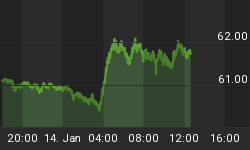Life is about managing expectations and we believe understanding market cycles helps investors navigate through the volatility of their investments. We often remind investors to "Anticipate Before You Participate" and I strongly urge you to read through our special presentation on managing volatility. Read the presentation ![]() here.
here.
This table shows the monthly volatility based on 10 years of data for a number of different investments. You can easily see each asset class has its own unique DNA of volatility.

For gold stocks, it's a normal event to see a positive or negative move of 11 percent over just one month's time. For emerging markets, it's just over 7 percent. Understanding this volatility is essential to removing emotional reactions and making the best investment decisions.
Recently, I've noticed many new faces on business television commenting about a bubble forming in commodities due to the Federal Reserve's Quantitative Easing (QE2) policy and resulting weakness in the U.S. dollar. Both of these are a part of the commodity equation but focusing on them omits several long-term factors driving commodities.
I do not see a bubble at this time but our quant models are showing we are due for a short-term correction. Investors need to anticipate this correction and not lose sight of the long-term trend.
We believe government policies are a precursor to change, and as a result, we monitor and track the fiscal and monetary policies of the world's largest countries both in terms of economic stature and population.
This table shows the population size and economic stature of the emerging world -- represented by what we like to call the E7 -- versus the developed world -- the G7.

You can see that the emerging world currently holds roughly half of the world's population but less than one-fifth of its economic clout. Already we are seeing a tremendous transformation of the emerging world and we don't think this imbalance will remain the case for long.
Most significant has been the doubling of the world's population since 1970, with 40 percent of the world's population being in China and India -- we affectionately call this region Chindia. Chindia has evolved from being isolationists 40 years ago to center stage on the global scene today.
With this population surge and integration into the global economy comes a need for new and improved infrastructure. Did you know that when the U.S. built its Interstate Highway System in the 1950s it consumed roughly half of the world's available commodities?
Today's equivalent of President Eisenhower's highway buildout is the network of subways and rapid transit systems China is constructing. This graphic from CICC charts the world's top ten cities by total length of rapid transit. With 410 kilometers of tracks, Shanghai reigns as king over cities like London, New York, Tokyo and Madrid.

Even more surprising is the pace at which they have been able to lay so many tracks. The first subway cars rolled down the tracks in London and New York during the 1860s but Shanghai's first subway wasn't operational until 1993. That means it took China 17 years to build what it took the UK and the U.S. 150 years to construct.
Shanghai and Beijing are the largest systems in China but recently many of the smaller cities, often referred to as Tier 2 cities, are hopping on board. The Chinese government has already approved construction for 28 rapid transit systems and 36 other cities have submitted applications for construction, according to CICC.
Our China analyst Michael Ding witnessed this firsthand while traveling in China last week. Michael was surprised to see a subway being constructed in his hometown of Dalian, a city of about 6 million. I had a similar surprising experience in New Delhi a couple of years ago when I traveled on the city's new, pristine subway system.
While short-term factors like the U.S. dollar's volatility and the Federal Reserve's QE2 program seem to grab the most attention, I believe the doubling of the world's population, massive infrastructure expansion like China's subways and the "free market policies" being embraced by the government leaders in the emerging world are much more significant.
For more updates on global investing from Frank and the rest of the U.S. Global Investors team, follow us on Twitter at www.twitter.com/USFunds or like us on Facebook at www.facebook.com/USFunds. You can also watch exclusive videos on what our research overseas has turned up on our YouTube channel at www.youtube.com/USFunds.
Standard deviation is a measure of the dispersion of a set of data from its mean. The more spread apart the data, the higher the deviation. Standard deviation is also known as historical volatility. All opinions expressed and data provided are subject to change without notice. Some of these opinions may not be appropriate to every investor. The S&P 500 Stock Index is a widely recognized capitalization-weighted index of 500 common stock prices in U.S. companies. The NYSE Arca Gold BUGS (Basket of Unhedged Gold Stocks) Index (HUI) is a modified equal dollar weighted index of companies involved in gold mining. The HUI Index was designed to provide significant exposure to near term movements in gold prices by including companies that do not hedge their gold production beyond 1.5 years. The MSCI Emerging Markets Index is a free float-adjusted market capitalization index that is designed to measure equity market performance in the global emerging markets. The U.S. Trade Weighted Dollar Index provides a general indication of the international value of the U.S. dollar.
















